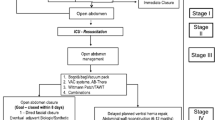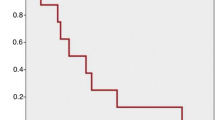Abstract
Background
Open abdomen (OA) treatment often results in difficulties in closing the abdomen. Highest closure rates are seen with the vacuum-assisted wound closure (VAWC) technique. However, we have experienced occasional failures with this technique in cases with severe visceral swelling needing longer treatment periods with open abdomen. Feasibility and short-term outcome of a novel combination of techniques for managing the open abdomen are presented.
Methods
The VAWC technique was combined with medial traction of the fasciae through a temporary mesh in seven consecutive patients. The VAWC-system was changed and the mesh tightened every 2–3 days.
Results
Median (range) age in the 7 men was 65 (17–78) years. The diagnoses were ruptured abdominal aortic aneurysm (AAA) (3), operation for juxtarenal AAA (1), iatrogenic aortic lesion (1), trauma (1) and abdominal abscesses (1). Four patients were decompressed due to abdominal compartment syndrome (ACS) or intra-abdominal hypertension, and 3 could not be closed after laparotomy. Intra-abdominal pressure prior to OA treatment was 24 (17–36) mmHg. Maximal separation of the fasciae was 16 (7 –30) cm. Delayed primary closure was achieved in all patients after 32 (12–52) days with OA. No recurrent ACS was seen. No technique-specific complication was observed. Two small incisional hernias, one intra-abdominal abscess and one wound infection occurred in three patients.
Conclusions
Delayed primary closure in cases with severe visceral swelling and long periods of OA seems feasible with this technique.


Similar content being viewed by others
References
Tsuei BJ, Skinner JC, Bernard AC, et al. (2004) The open peritoneal cavity: etiology correlates with the likelihood of fascial closure. Am Surg 70:652–656
Djavani K, Wanhainen A, Björck M (2006) Intra-abdominal hypertension and abdominal compartment syndrome following surgery for ruptured abdominal aortic aneurysm. Eur J Vasc Endovasc Surg 31:581–584
Schein M, Ivatury R (1998) Intra-abdominal hypertension and the abdominal compartment syndrome. Br J Surg 85:1027–1028
Howdieshell TR, Proctor CD, Sternberg E, et al. (2004) Temporary abdominal closure followed by definitive abdominal wall reconstruction of the open abdomen. Am J Surg 188:301–306
Jernigan TW, Fabian TC, Croce MA (2003) Staged management of giant abdominal wall defects: acute and long-term results. Ann Surg 238:349–357
Brock WB, Barker DE, Burns RP (1995) Temporary closure of open abdominal wounds: the vacuum pack. Am Surg 61:30–35
Wittmann DH, Aprahamian C, Bergstein JM (1990) Etappenlavage: advanced diffuse peritonitis managed by planned multiple laparotomies utilizing zippers, slide fastener, and VelcroR analogue for temporary abdominal closure. World J Surg 14:218–226
Fantus RJ, Mellett MM, Kirby JP (2006) Use of controlled fascial tension and an adhesion preventing barrier to achieve delayed primary fascial closure in patients managed with an open abdomen. Am J Surg 192:243–247
Garner GB, Ware DN, Cocanour CS, et al. (2001) Vacuum-assisted wound closure provides early fascial reapproximation in trauma patients with open abdomens. Am J Surg 182:630–638
World Society of the Abdominal Compartment Syndrome consensus definitions. www.wsacs.org
Kron IL, Harman PK, Nolan SP (1984) The measurement of intra-abdominal pressure as a criterion for exploration. Ann Surg 199:28–30
Stone PA, Hass SM, Flaherty SK, et al. (2004) Vacuum-assisted fascial closure for patients with abdominal trauma. J Trauma 57(5):1082–1086
Miller PR, Thompson JT, Faler BJ, et al. (2002) Late fascial closure in lieu of ventral hernia: the next step in open abdomen management. J Trauma 53:843–849
Stonerock CE, Bynoe RP, Yost MJ, et al. (2003) Use of a vacuum-assisted device to facilitate abdominal closure. Am Surg 69:1030–1035
Suliburk JW, Ware DN, Balogh Z, et al. (2003) Vacuum-assisted wound closure achieves early fascial closure of open abdomens after severe trauma. J Trauma 55:1155–1160
Miller PR, Meredith JW, Johnson JC, et al. (2004) Prospective evaluation of vacuum-assisted fascial closure after open abdomen. Planned ventral hernia rate is substantially reduced. Ann Surg 239:608–616
Israelsson LA, Jonsson T (1993) Suture length to wound length ratio and healing of midline laparotomy incisions. Br J Surg 80:1284–86
Author information
Authors and Affiliations
Corresponding author
Rights and permissions
About this article
Cite this article
Petersson, U., Acosta, S. & Björck, M. Vacuum-assisted Wound Closure and Mesh-mediated Fascial Traction—A Novel Technique for Late Closure of the Open Abdomen. World J Surg 31, 2133–2137 (2007). https://doi.org/10.1007/s00268-007-9222-0
Published:
Issue Date:
DOI: https://doi.org/10.1007/s00268-007-9222-0




